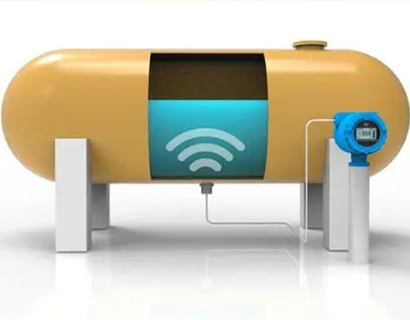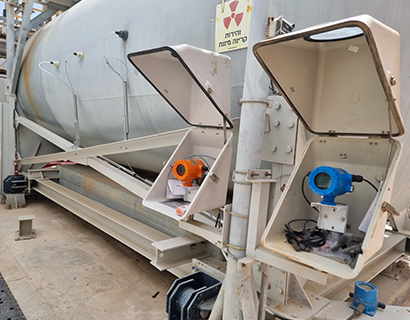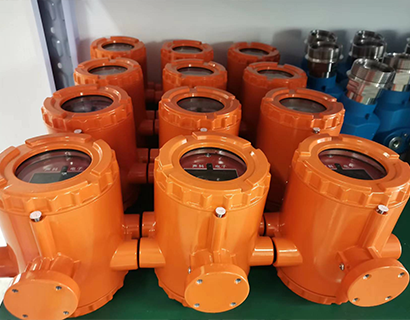The integrated external ultrasonic level sensor of SKE and the intelligent non-invasive level gauge can measure the liquid level in the tank by attaching the measuring sensor probe to the tank wall, also known as the external level sensor. This measurement method is very simple and belongs to a completely non-contact measurement. It solves many liquid level measurements with special requirements (such as strong acid, strong alkali, strong corrosive and high-pressure tanks that are difficult to open holes, etc.). And the instrument is safe and reliable during use.
The calibration sensor takes the liquid level measurement of a spherical tank in picture below as an example. The calibration sensor installed at the very circle position of the tank generates a beam of sonar signals in real time. When the liquid level exceeds the installation position of the calibration sensor, the host can use the timer to record the time T from the generation to the reception of the sonar signal, thereby obtaining the propagation speed V=4R/T of the sonar signal in the medium.


The measuring sensor installed at the bottom of the tank generates a sonar signal pointing to the liquid surface in real time. When the signal reaches the liquid surface, it is reflected. By recording the time taken by the measuring sensor from generation to reception as t, the liquid level height h=V*t/2 can be obtained. The external ultrasonic level sensor is different from the two-wire level sensor in that the four-wire instrument needs to be powered by a power supply. The power supply can be 24V/DC or 220V/AC. Signal transmission also supports 4-20mA standard signal and RS-485, HART communication interface.
The installation and maintenance of the SKE external level Sensor are convenient, and the tank can be operated without stopping the production. The instrument does not need to be calibrated regularly. It works reliably, has stable performance, and has a long service life.
Wide applications: It can measure various liquid media in highly toxic, strong acid, strong alkali, highly corrosive, and high-pressure environments. It has high measurement accuracy and sensitive instrument response. It is suitable for tank types such as spherical tanks, horizontal tanks, tanks, vertical tanks, etc.
As shown in the picture above, the instrument probe sends waves that hit the liquid level and then reflects back to the probe. After receiving the waves, the probe calculates the time from sending the waves to receiving the waves to get the measured distance. The current liquid level can be obtained by subtracting the measured distance from the instrument installation height (installation height - measurement distance - current liquid level).
The instrument range refers to the distance that the instrument can measure, and the installation height should be less than the range.
The instrument blind area refers to the area near the probe that the instrument cannot measure. The distance between the highest liquid level and the probe should be greater than the blind area. For example, if the blind area is 0.5m, the distance between the liquid level and the probe must be greater than 0.5m. The instrument blind area is included in the instrument range. For example: the blind area is 0.5m, the range is 5m, and the actual measurement can only be (0~4.5)m.
The wave emitted by the probe is a diffusion process, that is, there is a direction angle. Please pay attention when installing it, otherwise it may hit the protrusions on the pool wall or the edge of the channel.
Tank type: vertical tank, horizontal tank, spherical tank, tank, etc.
Container material: The container wall is preferably made of hard material, and the inner and outer surfaces of the container wall should be flat. Such as: stainless steel, carbon steel, other hard metals, resin, hard plastic, fiberglass, glass, hard rubber, ceramics and other materials. Tank wall thickness: 1-30mm, 2~70mm.

 CN
CN


